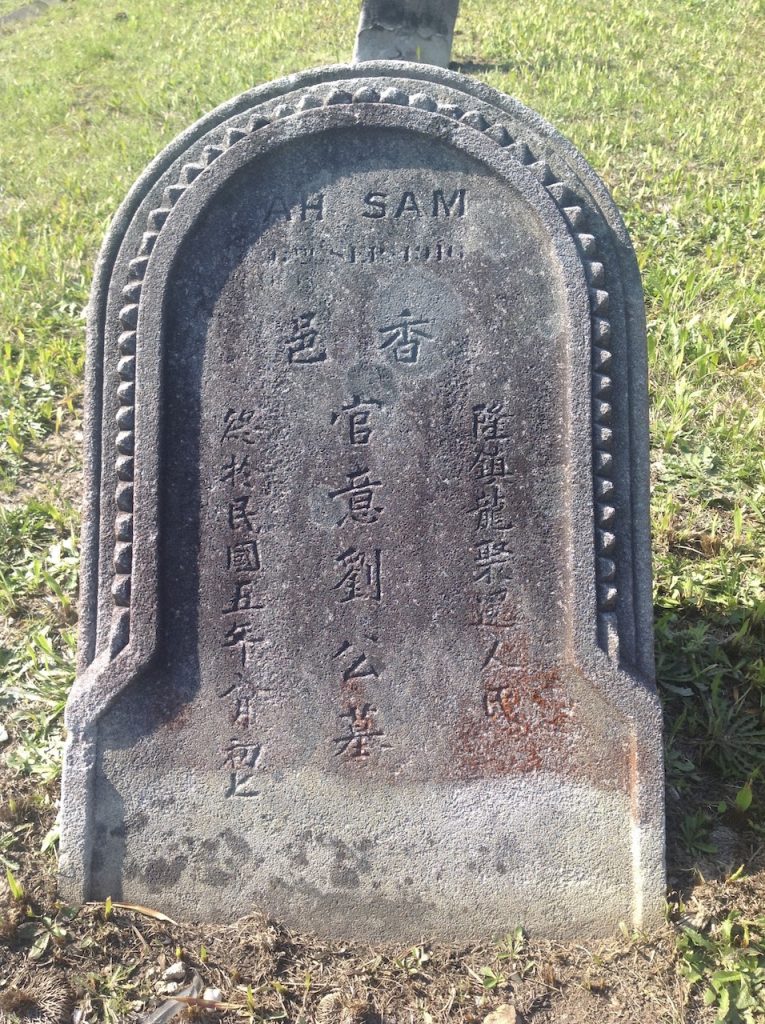
Despite age long efforts to set our names in stone the results very often are merely a stone with an unknown person’s name on it. From Ancient China and Rome to the cemeteries around Australia are to be found countless such grave makers and that of Ah Sam located in Sydney’s Rookwood Cemetery is just one of them. Or is it?
The name Ah Sam was certainly a common one in 19th century Australia and survives as a family name to this day in Queensland. But such romanisations adopted for everyday use among a largely non-Chinese speaking population tells us little. (See: On Chinese names.) A gravestone however being a formal thing usually takes on formal language and such is the case with most of the headstones over the graves of Chinese people buried in Australia also, including that of Ah Sam.
Thus, the bulk of this headstone is inscribed not with the roman letters of Ah Sam but with the Chinese script of his place of origin. And it is this place of origin among other things that tells us more about Ah Sam. In fact, most headstones made for Chinese burials in the 19th and early 20th century will contain at least the full name of the person (including the often otherwise unrecorded family name), the county or even village of birth and the date of death. All this is inscribed in traditional characters, mostly using literary Chinese and written vertically.
We therefore can read in the central column that Ah Sam’s full name was 官意劉 (Guan Yi Liao). Liao was his family name as pronounced in his native Long Du language with Cantonese speakers Lowe and Mandarin speakers pronouncing it Liu. The two characters following his name – 公 墓 mean the “grave of Mr”.
Just above the name and written horizontally is the county where our man was from, in this case 香邑 (written right to left on the headstone) with the 邑 being a formal way of expressing 縣 or county. 香邑 therefore means 香山 which after 1925 was renamed 中山 (Zhongshan). Further to Ah Sam’s place of birth we have the column on the right – 隆鎮龍聚還人氏 which tells us not only the district within Zhongshan but even his village. This is information not always provided. Thus 隆鎮 or more commonly 隆都 (Long Du) is his district and his village or 村 is Long Jui Wan / 龍聚還 (the last probably a mistake for 環), the final two characters 人氏 meaning he is a “person of” this locality.
Ah Sam or Mr Liao was therefore a man from a village within the district of Long Du. This is significant as this district was very prominent in sending people to Australia, Hawaii and San Francisco. It was also a district that spoke its own language unrelated to the Cantonese of wider Zhongshan. Ah Sam would have known many people in Sydney from this same district if not his own village as well. (See No. 45)
The final column on the right tells us the date that Ah Sam died. In this case using the Republican calendar adopted by China after its revolutionary overthrown of the Qing Dynasty in 1911. This calendar begins therefore in 1912 and so 民國五年 means “year 5 of the Republic” or 1916 as confirmed just below the Ah Sam at the top. The full line – 終於民國五年八月初七 – says: ‘Died on 5th year of the Republic, eight month, early seventh’. In the Lunar calendar that would be September.
Perhaps in the end we don’t know a great deal more about Ah Sam then we did at the beginning but we do know what his friends who ordered the headstone inscribed thought important to say about him. This was primarily where he came from as, if not Ah Sam himself, certainly many others would have desired to return to their places of origin even after death, as many did. (See No. 6)
See also: Reading an old Gravestone
Thanks to Ely Finch, Siaoman Yen and Douglas Lam for their input. All errors remain mine.

